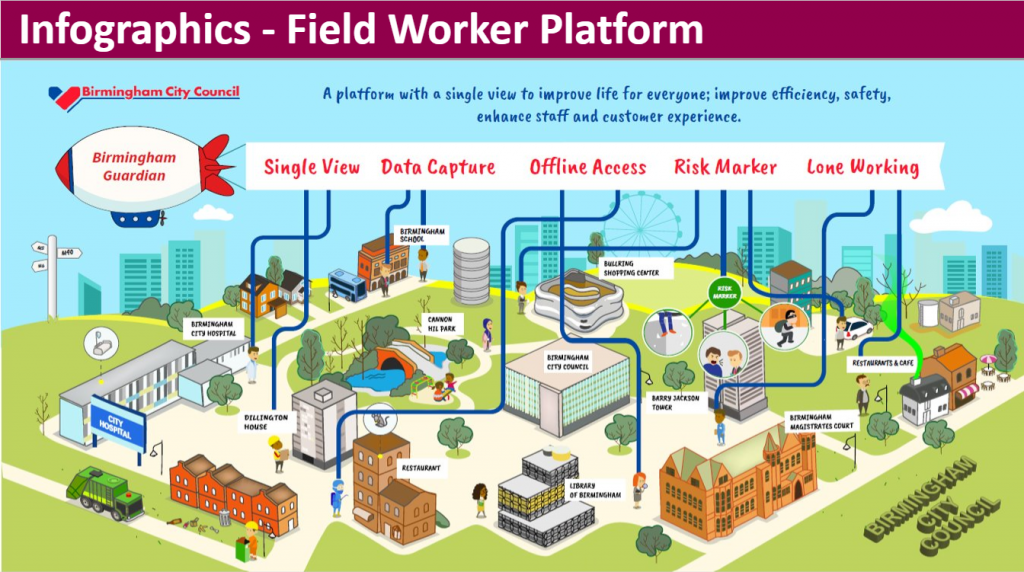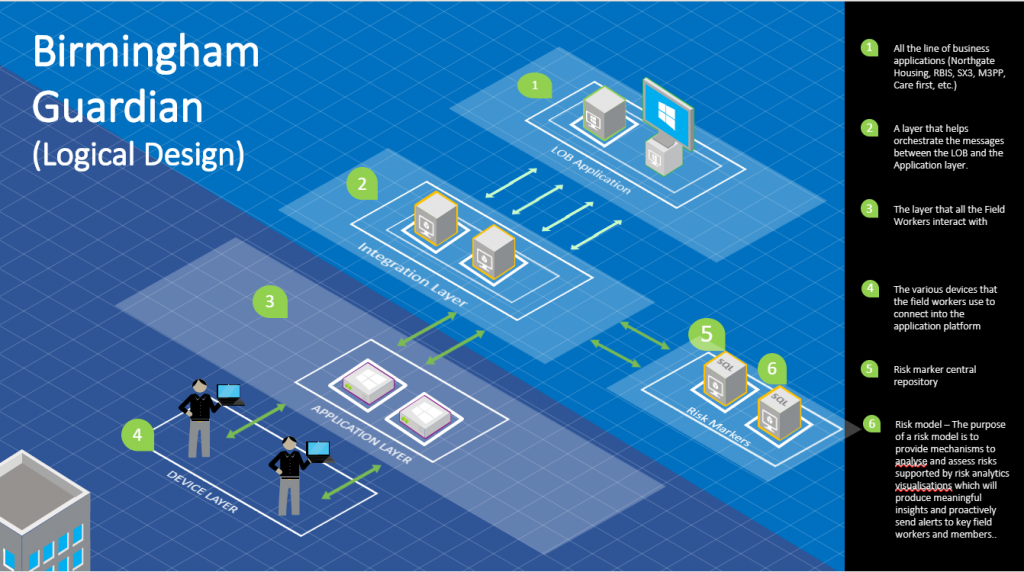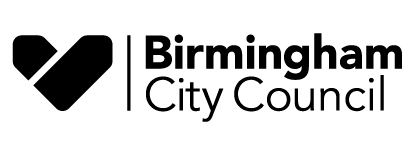Since we just heard the great news that we were successful in our bid for Local Digital Fund round 5, that’s what James will be talking about in his first blog post:
The project we applied for is one we have taken through discovery and alpha over the past year and were getting ready to start beta when the funding opportunity arose. It’s also one I’m very passionate about, having invested a lot of my own time in developing and championing this way of working.
So, what’s the project? Well, fundamentally it’s a single, low-cost platform for local authority field workers. In Birmingham we have as many as 7,000 people we would classify as field workers. They are the foot soldiers who spend their days face to face serving the citizens and businesses of our city. The services they provide range from social care to environmental health to housing, street scene and everything in-between. Our discovery work found that their technology and processes are inconsistent and sub-optimal for the level of delivery they aspire to for their customers. Giving them a single platform will:
• Give field workers a consistent and user-friendly interface and presentation of their casework
• Give them access to the information they need to do their jobs in the field without the need to connect directly to line of business systems
• Allow them to record information even when offline in areas of poor or no connectivity and then update the line of business system silently and safely in the background when connection is restored
• Keep them safer by integrating a central Risk Marker database to give them information about people or places that may present a risk to their safety
• Free up their time from administration and double handling to give them more time with customers.

The beta project is the result of a comprehensive discovery stage where we spoke to field workers from across 42 service areas to understand their pain points and needs. We identified a set of both pain points and needs that was common across field workers regardless of the specific service they provide. At the end of the Discovery we developed the following hypothesis:
“We believe providing a platform that allows information to be received, allocated, recorded and retrieved at offline and remote locations with a single view of multiple backend systems and efficient reporting functionality will result in an improvement of the productivity and usability. We will have confidence to proceed when we see a reduction of time spent on each case and improvement of user experience.”
You can read the Discovery report here.
During alpha stage we assessed the merits of using proprietary applications versus building our own – and decided that building our own would be much better value and also allow us to develop continuously which we could not if we bought off the shelf. In Alpha we tested the most risky elements of the build to give confidence in our ability to deliver a platform. You can read the Alpha report here.
The platform design comprises 3 key elements:
- A device-agnostic application layer that will be the user interface. It will have a standardised look and feel for all field workers; will be accessed through single sign on; and will be optimised for each on-boarding team
- The integration layer which will be the ‘enterprise bus’ passing data between the application layer and the line of business systems
- The central Risk Marker database.

The platform will be developed to enable any field work team to be onboarded onto the base platform, with the possibility to configure each specific user journey with minimal effort. We have identified several early adopter service areas who will be involved in our private beta.
Through the first two stages of work we have built some amazing support from a group of people who represent the main services. They are effectively a product owner collective, supported in their quest by an experienced product owner we have planted into the core project team. The PO group has defined a key set of features for the platform that will be delivered as the beta minimal viable product, including being able to:
- view jobs and risks recorded in line of business systems
- capture and update data into the line of business application
- complete proof of service and add job evidence
- establish a workflow
- pre-populate forms
- enable alerts to be pushed to people
- enable offline working.
The MVP will be delivered by 3 scrum teams (one for each core element of the platform) over 8 sprints between now and March 2022. You can view the high level sprint plan here.
In terms of the technology we will use to build the platform, here are the basics:
• Azure Data Lake
• Azure SQL Services
• Azure Analysis Services
• Azure Data Factory
• Power Platform
• Restful API Development / Azure API Management
• Azure Functions and Logic Apps
• API Management / API Gateway
• Event Grid / Managed event service
• Azure Redis Cache and Azure Storage
• xamarin/.net maui.
The field worker solution will be accessing data via APIs from several line of business applications and holding that data temporarily within the platform while it provides it to the users via a mobile app. We have ensured our solution has end to end data security with both application and infrastructure security.
And the great news for us is that with the funding from the Local Digital Fund, we will be exploring how we can support other local authorities to adopt this technology and potentially move away from more expensive solutions for field working. Watch this space for information about show and tells and how you can get involved if this is something you’re interested in!
Getting this project off the ground has been a really interesting journey in itself and will be the subject of a follow-up blog post. Watch this space!
I’ve posted this blog on behalf of James Gregory (Head of IT & Digital Programmes), if you’d like more information, please reach out to him via [email protected]

Are you able to share the evaluation which led you to Azure for this solution?
Hi Matthew, thanks for your question. Do you mind sending an email to [email protected] with your details and one of the Field Worker project team will come back to you.
Best Wishes
Surita